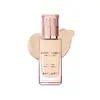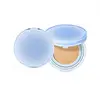What's inside
What's inside
 Key Ingredients
Key Ingredients

 Benefits
Benefits

 Concerns
Concerns

 Ingredients Side-by-side
Ingredients Side-by-side

Water
Skin ConditioningCyclopentasiloxane
EmollientTitanium Dioxide
Cosmetic ColorantTrimethylsiloxysilicate
EmollientButylene Glycol
HumectantIsododecane
EmollientDimethicone
EmollientPentylene Glycol
Skin ConditioningPEG/PPG-18/18 Dimethicone
EmulsifyingPEG-9 Polydimethylsiloxyethyl Dimethicone
EmulsifyingHydrolyzed Collagen
EmollientMagnesium Sulfate
Polyglyceryl-3 Diisostearate
EmulsifyingPolymethylsilsesquioxane
Tridecyl Trimellitate
EmollientTocopheryl Acetate
AntioxidantAluminum Hydroxide
EmollientTribehenin
EmollientDisteardimonium Hectorite
StabilisingPolypropylsilsesquioxane
Stearic Acid
CleansingTriethoxycaprylylsilane
Caprylyl Glycol
EmollientGlyceryl Caprylate
EmollientPropylene Carbonate
SolventPEG-10 Dimethicone
Skin Conditioning1,2-Hexanediol
Skin ConditioningXanthan Gum
EmulsifyingDisodium EDTA
Parfum
MaskingChromium Hydroxide Green
Ferric Chloride
AstringentFerrous Fumarate
Skin ConditioningWater, Cyclopentasiloxane, Titanium Dioxide, Trimethylsiloxysilicate, Butylene Glycol, Isododecane, Dimethicone, Pentylene Glycol, PEG/PPG-18/18 Dimethicone, PEG-9 Polydimethylsiloxyethyl Dimethicone, Hydrolyzed Collagen, Magnesium Sulfate, Polyglyceryl-3 Diisostearate, Polymethylsilsesquioxane, Tridecyl Trimellitate, Tocopheryl Acetate, Aluminum Hydroxide, Tribehenin, Disteardimonium Hectorite, Polypropylsilsesquioxane, Stearic Acid, Triethoxycaprylylsilane, Caprylyl Glycol, Glyceryl Caprylate, Propylene Carbonate, PEG-10 Dimethicone, 1,2-Hexanediol, Xanthan Gum, Disodium EDTA, Parfum, Chromium Hydroxide Green, Ferric Chloride, Ferrous Fumarate
Water
Skin ConditioningDibutyl Adipate
EmollientTitanium Dioxide
Cosmetic ColorantPropanediol
SolventEthylhexyl Salicylate
UV AbsorberHomosalate
Skin ConditioningEthylhexyl Triazone
UV AbsorberNiacinamide
SmoothingDiethylamino Hydroxybenzoyl Hexyl Benzoate
UV FilterButyloctyl Salicylate
Skin ConditioningCoco-Caprylate/Caprate
Emollient1,2-Hexanediol
Skin ConditioningCaprylic/Capric Triglyceride
MaskingPanthenol
Skin ConditioningPhenyl Trimethicone
Skin ConditioningAdansonia Digitata Fruit Extract
EmollientPrunus Persica Flower Extract
MoisturisingHydrogenated Lecithin
EmulsifyingSodium Hyaluronate
HumectantPentylene Glycol
Skin ConditioningPolyhydroxystearic Acid
EmulsifyingGlyceryl Stearate
EmollientIsononyl Isononanoate
EmollientButylene Glycol
HumectantHydroxypropyl Methylcellulose Stearoxy Ether
Triethoxycaprylylsilane
Polyacrylate Crosspolymer-6
Emulsion StabilisingAluminum Hydroxide
EmollientPEG-240/Hdi Copolymer Bis-Decyltetradeceth-20 Ether
StabilisingAmmonium Acryloyldimethyltaurate/Vp Copolymer
Ethylhexylglycerin
Skin ConditioningAlumina
AbrasiveStearic Acid
CleansingAdenosine
Skin ConditioningT-Butyl Alcohol
PerfumingPolyglyceryl-3 Polydimethylsiloxyethyl Dimethicone
Skin ConditioningSodium Acrylate/Sodium Acryloyldimethyl Taurate Copolymer
Emulsion StabilisingCeramide NP
Skin ConditioningPolyisobutene
Tocopherol
AntioxidantPEG-10 Rapeseed Sterol
CleansingPotassium Laurate
EmulsifyingDipropylene Glycol
HumectantSorbitan Oleate
EmulsifyingCaprylyl/Capryl Glucoside
CleansingGlycereth-20
HumectantDimethylsilanol Hyaluronate
HumectantHydrolyzed Sodium Hyaluronate
Skin ConditioningHydrolyzed Hyaluronic Acid
HumectantPotassium Hyaluronate
Skin ConditioningHyaluronic Acid
HumectantSodium Hyaluronate Crosspolymer
HumectantHydroxypropyltrimonium Hyaluronate
Sodium Hyaluronate Dimethylsilanol
HumectantSodium Acetylated Hyaluronate
HumectantParfum
MaskingCI 77492
Cosmetic ColorantCI 77491
Cosmetic ColorantCI 77499
Cosmetic ColorantWater, Dibutyl Adipate, Titanium Dioxide, Propanediol, Ethylhexyl Salicylate, Homosalate, Ethylhexyl Triazone, Niacinamide, Diethylamino Hydroxybenzoyl Hexyl Benzoate, Butyloctyl Salicylate, Coco-Caprylate/Caprate, 1,2-Hexanediol, Caprylic/Capric Triglyceride, Panthenol, Phenyl Trimethicone, Adansonia Digitata Fruit Extract, Prunus Persica Flower Extract, Hydrogenated Lecithin, Sodium Hyaluronate, Pentylene Glycol, Polyhydroxystearic Acid, Glyceryl Stearate, Isononyl Isononanoate, Butylene Glycol, Hydroxypropyl Methylcellulose Stearoxy Ether, Triethoxycaprylylsilane, Polyacrylate Crosspolymer-6, Aluminum Hydroxide, PEG-240/Hdi Copolymer Bis-Decyltetradeceth-20 Ether, Ammonium Acryloyldimethyltaurate/Vp Copolymer, Ethylhexylglycerin, Alumina, Stearic Acid, Adenosine, T-Butyl Alcohol, Polyglyceryl-3 Polydimethylsiloxyethyl Dimethicone, Sodium Acrylate/Sodium Acryloyldimethyl Taurate Copolymer, Ceramide NP, Polyisobutene, Tocopherol, PEG-10 Rapeseed Sterol, Potassium Laurate, Dipropylene Glycol, Sorbitan Oleate, Caprylyl/Capryl Glucoside, Glycereth-20, Dimethylsilanol Hyaluronate, Hydrolyzed Sodium Hyaluronate, Hydrolyzed Hyaluronic Acid, Potassium Hyaluronate, Hyaluronic Acid, Sodium Hyaluronate Crosspolymer, Hydroxypropyltrimonium Hyaluronate, Sodium Hyaluronate Dimethylsilanol, Sodium Acetylated Hyaluronate, Parfum, CI 77492, CI 77491, CI 77499
 Reviews
Reviews

Ingredients Explained
These ingredients are found in both products.
Ingredients higher up in an ingredient list are typically present in a larger amount.
1,2-Hexanediol is a synthetic liquid and another multi-functional powerhouse.
It is a:
- Humectant, drawing moisture into the skin
- Emollient, helping to soften skin
- Solvent, dispersing and stabilizing formulas
- Preservative booster, enhancing the antimicrobial activity of other preservatives
Aluminum Hydroxide is a form of aluminum. It can be naturally found in nature as the mineral gibbsite. In cosmetics, Aluminum Hydroxide is used as a colorant, pH adjuster, and absorbent.
As a colorant, Aluminum Hydroxide may add opacity, or reduce the transparency. Aluminum hydroxide is contains both basic and acidic properties.
According to manufacturers, this ingredient is an emollient and humectant. This means it helps hydrate the skin.
In medicine, this ingredient is used to help relieve heartburn and help heal ulcers.
There is currently no credible scientific evidence linking aluminum hydroxide in cosmetics to increased cancer risk.
Major health organizations allow the use of aluminum hydroxide in personal care products and have not flagged it as a carcinogenic risk at typical usage levels.
Learn more about Aluminum HydroxideButylene Glycol (or BG) is used within cosmetic products for a few different reasons:
Overall, Butylene Glycol is a safe and well-rounded ingredient that works well with other ingredients.
Though this ingredient works well with most skin types, some people with sensitive skin may experience a reaction such as allergic rashes, closed comedones, or itchiness.
Learn more about Butylene GlycolParfum is a catch-all term for an ingredient or more that is used to give a scent to products.
Also called "fragrance", this ingredient can be a blend of hundreds of chemicals or plant oils. This means every product with "fragrance" or "parfum" in the ingredients list is a different mixture.
For instance, Habanolide is a proprietary trade name for a specific aroma chemical. When used as a fragrance ingredient in cosmetics, most aroma chemicals fall under the broad labeling category of “FRAGRANCE” or “PARFUM” according to EU and US regulations.
The term 'parfum' or 'fragrance' is not regulated in many countries. In many cases, it is up to the brand to define this term.
For instance, many brands choose to label themselves as "fragrance-free" because they are not using synthetic fragrances. However, their products may still contain ingredients such as essential oils that are considered a fragrance by INCI standards.
One example is Calendula flower extract. Calendula is an essential oil that still imparts a scent or 'fragrance'.
Depending on the blend, the ingredients in the mixture can cause allergies and sensitivities on the skin. Some ingredients that are known EU allergens include linalool and citronellol.
Parfum can also be used to mask or cover an unpleasant scent.
The bottom line is: not all fragrances/parfum/ingredients are created equally. If you are worried about fragrances, we recommend taking a closer look at an ingredient. And of course, we always recommend speaking with a professional.
Learn more about ParfumPentylene glycol is typically used within a product to thicken it. It also adds a smooth, soft, and moisturizing feel to the product. It is naturally found in plants such as sugar beets.
The hydrophilic trait of Pentylene Glycol makes it a humectant. As a humectant, Pentylene Glycol helps draw moisture from the air to your skin. This can help keep your skin hydrated.
This property also makes Pentylene Glycol a great texture enhancer. It can also help thicken or stabilize a product.
Pentylene Glycol also acts as a mild preservative and helps to keep a product microbe-free.
Some people may experience mild eye and skin irritation from Pentylene Glycol. We always recommend speaking with a professional about using this ingredient in your routine.
Pentylene Glycol has a low molecular weight and is part of the 1,2-glycol family.
Learn more about Pentylene GlycolStearic Acid is a fatty acid. It is an emollient, emulsifier, and texture enhancer.
As an emollient, stearic acid helps soften skin. It aids the skin's protective barrier by preventing water loss. It also provides a gentle cleansing effect without stripping away natural oils.
Stearic acid may also be used to enhance the texture of products. It can add volume and stabilize ingredients such as water and oil. This can help water and oil ingredients from separating.
Sources of stearic acid include animal or vegetable fats/oils such as coconut or shea. It can be naturally found in butter, cocoa butter, shea butter, vegetable fats, and animal tallow.
This ingredient may not be Malassezia folliculitis, or fungal-acne safe.
Learn more about Stearic AcidTitanium dioxide is a mineral UV filter widely used in sunscreens and cosmetics.
It is one of only two UV filters officially classified as “mineral” by regulatory agencies, the other being zinc oxide.
Titanium dioxide provides broad-spectrum protection mostly in the UVB and UVAII range, with some protection in the UVAI range.
While its UVA protection isn’t as strong as zinc oxide’s, the difference is minor.
A common myth is that mineral UV filters reflect UV light. However, modern research shows titanium dioxide absorbs UV radiation like chemical filters (~95% absorption & 5% reflection).
Thanks to its non-irritating nature, titanium dioxide is suitable for sensitive, acne-prone, or redness-prone skin. It is unlikely to cause "eye sting" like other sunscreen ingredients.
A major drawback of this ingredient is its white cast and thick texture. This is why mineral sunscreens often leave a white cast and are less cosmetically elegant than chemical/hybrid sunscreens.
To improve white cast and spreadability, micronized or nano-sized titanium dioxide is often used.
There are ongoing concerns surrounding nano-titanium oxide's impact on marine ecosystems.
There is no conclusive evidence that any form of titanium oxide (or any other sunscreen ingredients) will cause harm to marine ecosystems or coral reefs. The science is still developing but many consumers are keeping a close eye on this issue.
Please note, many destinations have reef-safety sunscreen rules. For instance, the U.S. Virgin Islands advises all visitors to use non-nano mineral sunscreens.
Nano mineral sunscreens once raised safety concerns about absorption into skin.
Extensive research has shown that they do not penetrate healthy or damaged skin; they remain safely on the surface and the top layer of dead skin (stratum corneum).
You'll likely find titanium dioxide bundled with alumina, silica, or dimethicone. These ingredients help make titanium dioxide highly photostable; this prevents it from interacting with other formula components under UV light.
Learn more about Titanium DioxideTriethoxycaprylylsilane is a silicone used to bind and stabilize ingredients.
As an emulsifier, it helps prevent ingredients from separating. This can help elongate the shelf life of products.
Triethoxycaprylylsilane is often used to coat mineral sunscreens ingredients to help give a better feel. It also helps reduce oxidative stress in sunscreens.
Learn more about TriethoxycaprylylsilaneWater. It's the most common cosmetic ingredient of all. You'll usually see it at the top of ingredient lists, meaning that it makes up the largest part of the product.
So why is it so popular? Water most often acts as a solvent - this means that it helps dissolve other ingredients into the formulation.
You'll also recognize water as that liquid we all need to stay alive. If you see this, drink a glass of water. Stay hydrated!
Learn more about Water